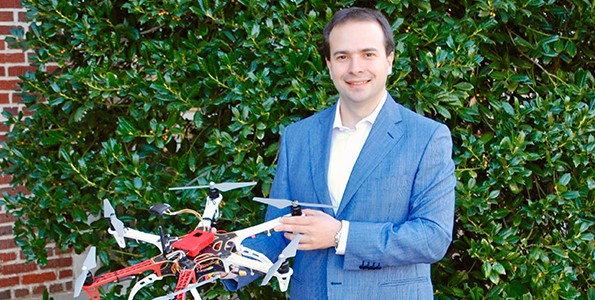When you imagine the future, what do you see? Towering skyscrapers, self-driving cars, cryptocurrency, or smart homes?
When Andrea L’Afflitto Ph.D., an Assistant Professor at the University of Oklahoma, imagines the future, he sees drones: pizza delivery drones, drones as personal assistants, drones with the ability to run our errands and even help people with limited mobility perform tasks.
“A lot of people compare the potential for drones to the advent of the car. Once the technology was created, it was impossible to truly appreciate the impact it would have,” said L’Afflitto.
There’s a whole world of untapped potential when it comes to new drone technology, and research at OU is at the threshold of this new frontier.
“In the end, I’d like to see mobile devices that act autonomously,” said L’Afflitto. “To support people and enhance our productivity. To relieve people from repetitive tasks that are not needed or can be performed better with the help of a machine.”
L’Afflitto specializes in control theory in Aerospace and Mechanical Engineering. “I started being really passionate about aircrafts when I was 18,” he explained. He graduated from college in Italy and worked in Germany for a while before coming to the United States where he received his PhD. from Georgia Tech in 2015.
“My area of research is called adaptive control, where basically the computer on board learns or adapts everytime you uses it,” L’Afflitto explained. “So, it improves its performance as time goes by. After 5 to 10 times, we definitely see better quality of flight than before. This is one of the key technologies which is relatively new.”
He and a team of twelve graduate and undergraduate students are working on the underlying mathematical problems associated with combining artificial intelligence with flight.
“We want drones to act in a smart, or semi smart way,” said L'Afflitto. “We want to say, ‘find a bottle, pick it up, and bring it back to me,’ and have the drone complete that task.”
But, even this simple command presents several obstacles. First the drone has to understand what the command is. Then in order to complete it, it has to be able to recognize a water bottle and navigate safely to it.
These problems are the technological hurdles researchers have to overcome before bringing drones into our homes and workspaces as personal assistants.
The work being done on drone capabilities at the University of Oklahoma is uncharted territory. The possibilities are endless, presenting interesting challenges to Dr. L’Afflitto and his team, but the potential to use drone technology to improve the quality of life for people around the world is a worthwhile reason to overcome those obstacles.



